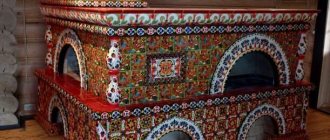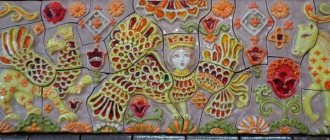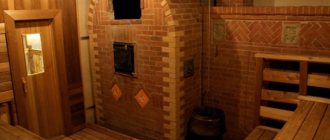The floors of the 12th-century chambers of the prince of the lands of Vladimir, Suzdal and Rostov Andrei Bogolyubsky are entirely lined with colored tiles with images of griffins, half-lions, half-eagles - symbols of princely power. Archaeologists found the same tiles dating back to the 14th century in Galich, Chernigov and Grodno.
The art of architectural glazed ceramics flourished in Rus' before the Tatar invasion. It is unknown what development the art of tiles would have received in Russia if not for the Horde yoke. According to historians, despite the positive moment of “gathering lands” and establishing a unified statehood in Rus', the Horde yoke destroyed technologies and complex crafts, such as cloisonne enamel, glass, polychrome ceramics, known to the ancient Russians long before the appearance of these technologies in Europe.
Soviet archaeologist, researcher of Slavic culture and history of Ancient Rus', academician of the Russian Academy of Sciences B. A. Rybakov writes in his book “The Craft of Ancient Rus'”: “Rus was thrown back several centuries, and in those centuries when the guild industry of the West transferred to "In the era of primitive accumulation, the Russian handicraft industry had to go through again part of the historical path that was done before Batu."
Only in the cities that escaped the Horde's slaughter were crafts preserved and developed, which spread after the liberation of Rus' in other Russian lands. One of these cities was Pskov.
Glazed tiles. Pskov
In the mid-60s, during the restoration of the Cathedral of the Spaso-Mirozhsky Monastery in Pskov, restoration artists discovered in the attic of the cathedral ancient tiles of glazed ceramics in a red-green glaze, which they attributed to the end of the 13th - beginning of the 14th centuries. The glaze on the dome of the Mirozhsky Monastery Cathedral glowed like a green light in the rays of the sun. Reflections of this radiance decades later flashed on the domes of other Pskov churches. The heads of many city churches were dressed in tiles. Over the decades, the tiles have become smaller and neater, and the glaze on them has become juicier and thicker.
A real treasury of glazed ceramics is the Pskov-Pechora Monastery, where, among dozens of limestone boards, glazed gravestones—the famous Pskov ceramides—glow with a green sheen. Ceramides are large ceramic slabs, glazed, with complex patterned relief and inscriptions, usually the name of the person buried and dates. Ceramides were made in the same way as the first books - using collapsible molds. The conclusion immediately suggests itself that the creators of ancient ceramides were familiar with printing technology. It is believed that the technology was suggested to the master tile makers by Cornelius, the abbot of the monastery, a great bookworm and a very educated man. The oldest ceramide dates back to 1530.
Pskov masters were known far beyond the borders of Pskov. Artels of Pskovites worked in many cities of the Moscow kingdom. In 1477, Pskov craftsmen erected the Spiritual Church in the Trinity-Sergius Monastery. The Spiritual Church has a special decoration: at the base of its zakomar there is a decorative belt made of relief terracotta slabs. The Church of the Deposition of the Robe in the Moscow Kremlin, built in 1485, is decorated with the same slabs.
Most common problems
The most pressing problem when using tiles as finishing is the significant discrepancies in their sizes. Even sets made to order can unpleasantly surprise you with discrepancies of up to 10 cm. “This is handmade,” say the manufacturers, but they still take some tiles for rework.
In addition, some mass-produced industrial kits can be even better than “exclusive” ones, while being significantly cheaper.
You need to purchase tiles from a master whose work you have seen at work or take advice from those who have experience. External beauty is one side of the coin, but correcting a large error in size is very difficult, and sometimes the material gets damaged during fitting.
Glazed tiles. Moscow
Interesting ancient finds were discovered by restorers during work in the Intercession Cathedral (St. Basil's Cathedral). On the central tent, under a layer of later paintings, colored ancient tiles were discovered, laid into the walls at the time of construction of the cathedral, which was originally built whitewashed. Made of light clay, covered with yellowish, brown or green glassy glaze, in the shape of stars - these colored tiles looked like precious stones on the white wall of the temple - a technique previously unprecedented in Rus'. A similar tiled decor was on the Church of Sergius at the Epiphany Monastery, destroyed in 1807. In fact, these were the first colored glazed tiles after Pskov.
Tile production technology
Tile cladding is the most expensive and complex of all types of finishing. This is due to the manufacturing technology of the product.
For the production of ceramic tiles, prepared and purified terracotta clay is used. Before starting work, it is kneaded and left to “rest” for several weeks. It is then placed into a mold. It is worth noting that clay shrinks, which is why the molds are made 5-10% larger (depending on the type of clay). Previously, clay molds were used for work, today they have been replaced by plaster structures.
The mold filled with clay is dried. Moreover, this process is natural and quite complex. The product should not be exposed to drafts or dried too quickly. This will cause it to crack.
The dried tile is fired, covered with glaze, and a design is applied. The work ends with another firing, which lasts a day. At the same time, under the influence of temperature, the front part of the coating may change shade. That is why products need to be sorted before stacking.
Due to the fact that the entire technological process is carried out almost manually, tiles are piece products and expensive. As a rule, tiles are made to order, the quantity is calculated according to the size of the stove or fireplace. The cost of a set of handmade tiles for a stove can reach 100-150 thousand rubles. Plus, cladding work. Tiled stoves are not a cheap pleasure. However, you can do everything yourself, from making tiles to finishing the stove.
We recommend - step-by-step instructions on how to make tiles with your own hands
Polychrome tiles
Unique colored tiles can be seen on the Assumption Cathedral in Dmitrov: huge tiled bas-reliefs, about three meters high, sparkle with colored glazes on the north and south sides of the cathedral. The absolutely unique bas-relief with St. George the Victorious has a diameter of 2.93 m and consists of 32 tiles with relief up to 7 cm in depth. Relief colored tiles of this size were something completely new for Russia. No one had ever done anything like this before.
But the real revolution in fine art was the construction of the New Jerusalem Monastery by Patriarch Nikon, in which the principles of the Italian Renaissance were first applied: orders, rosettes, ionics, leaves, etc. But the most important thing is that the foreign masters whom Nikon brought introduced a new palette of glazes was introduced into Russian tile art: for the first time, dull glassy enamels began to be used and blue and white pigments were introduced into use. The tiles of the New Jerusalem Monastery amazed with their multicolored colors.
Tens of thousands of polychrome tiles decorated the majestic monastery on the banks of the Istra River. The construction of the New Jerusalem Cathedral helped Russian architects understand the role of multi-colored tiles in the decoration of buildings. The craftsmen needed approximately 60 different types of relief to create grandiose panels, friezes, and iconostases. They found patterns and drawings for them on the pages of printed books and on fabrics. The “peacock's eye” pattern, so often used later on the tiles of many Moscow churches, was taken from Italian velvets of the late 16th century. Many tiles were made by Nikon masters according to the laws of Western European architecture of the 16th-17th centuries.
It should be noted that Belarusian masters who moved from Western lands to Moscow from the persecution of the Catholic Polish-Lithuanian Commonwealth had a great influence on Russian architecture of the 17th century. Being under the rule of the Polish gentry, natives of Belarusian cities had the opportunity to become acquainted with Western European architecture and art. By 1654, Belarusians were already migrating in the thousands. According to the census of 1676, about ten percent of the population of Moscow were immigrants from Western lands, who brought their knowledge and professional skills to their new homeland. The amazing flourishing of Russian architecture under Alexei Mikhailovich Romanov was greatly facilitated by the influx of fresh “spiritual blood” from the West.
In 1654, Prince Trubetskoy brought potter Stepan Ivanov from Mstislavl, who later became famous under the name Stepan Polubes. And already in 1658, Patriarch Nikon took him for the construction of the New Jerusalem Temple. In general, the ceramics of Stepan Polubes are on a par with the works of the Italian ceramists of the della Robbia family and the Frenchman Bernard Palissy: its significance for world art is quite comparable to the scale of the great ceramists of the Renaissance. Many works by Stepan Polubes have been preserved in Moscow. In addition to the tiles in the New Jerusalem Monastery, impressive are the huge high reliefs in the Church of the Assumption in Goncharnaya Sloboda, tiles in the Church of Gregory of Neokesarea on Bolshaya Polyanka, the “peacock eye” friezes on the cathedral in Izmailovo and many other miraculously preserved examples of architectural ceramics by the prolific master.
In the last decade of the 17th century, Moscow, as if foreseeing the imminent birth of a new capital on the Neva, sought to decorate itself with exquisite churches and residential buildings. St. Basil's Cathedral, which had recently been whitewashed, was colored. Peaked tents grew on the Kremlin towers. When constructing buildings, Russian architects tried to decorate them as magnificently as possible. Moscow architects of this period are concerned with the “sculptural” appearance of the building and the complexity of its silhouette.
One of the last monuments of the capital's tile makers was the Krutitsky Teremok, completely lined with multi-colored tiles. Hundreds of tiles with intricate floral patterns made up a huge carpet with a unique pattern on the facade of the building. The window frames are also made of clay and covered with colored glaze. They are made in the tradition of fashionable wood carving in the form of twisted vines. On sunny days, when green, yellow, white, blue and brown reflections flashed, the tower resembled a precious piece of jewelry. The Krutitsky tower became the last and most colorful monument of boyar Rus'.
How to make tiles with your own hands
A master class on making tiles will be of interest to those who decided to take on the task on their own. The work is not difficult, but painstaking and very exciting. Knowing the nuances of each operation will help you avoid disappointment and get a quality product.
Preparation for work includes: purchasing gypsum putty for making a mold and special clay for the product. The equipment will require knives or stacks and a muffle furnace for firing. Step-by-step instructions that will allow you to make a tile in accordance with the traditions of Russian craftsmen will not be superfluous.
Yaroslavl tiles
There is probably no other city in Russia where architectural ceramics would find such wide and widespread use. Yaroslavl was the second most important city after Moscow, and the wealth accumulated in Yaroslavl exceeded the state treasury in size. There was open rivalry between Moscow and Yaroslavl, and the coincidence of tastes of masters and customers led to the fact that the features of folk art were especially strongly reflected in Yaroslavl architecture. The art of polychrome tiles reached its peak in Yaroslavl.
Yaroslavl craftsmen created their own color scheme and a recognizable typical Yaroslavl pattern. Almost all Yaroslavl tiles have a single compositional principle: a multi-color rosette painted in different colors. There are six types of rosettes in total: four with eight large petals, one with six and one with twelve.
Yaroslavl potters were ahead of their time in the use of glazed bricks - only today this technique is used widely and everywhere. The Yaroslavl residents covered the side of the brick with glaze, applying a series of colored diamonds to it. Ribbons of such elegant bricks border wide tiled cornices with embossed floral patterns. There is an opinion that the intricate patterns of the tile trims came from precious oriental carpets, which were often found in Yaroslavl from Asia along the busy trade road - the Volga.
Types of tiles for stoves and fireplaces
By shape
The tile can only be laid intact on the stove, otherwise its unique heat accumulation properties will be reduced to zero. Therefore, from the point of view of the form for tiles, there are three main elements:
- flat (front). Designed for cladding smooth surfaces;
- corner. Accordingly, for facing corners;
- shaped. They allow you to veneer protruding parts (for example, cornices) and highlight zones. Mainly used as decorative tiles.
Shapes of tiles
The variety of tile shapes is not limited to standard elements; there are different options (as in the picture)
According to the structure of the front surface
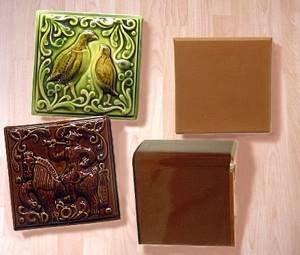
Relief and smooth tiles - relief; - smooth.
Material prepared for the website www.moydomik.net
By surface type
Glazed tiles - glazed (glossy);
- not glazed tiles (terracotta) not glazed (matte, terracotta). This type has a lower price compared to glazed products.
According to the presence of the picture:
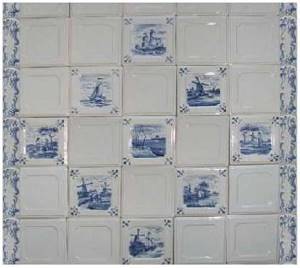
Tiles with a pattern - with a pattern;
Tiles without a pattern are without a pattern.
By ornament style
The themes of the drawings and the color scheme of the tiles convey the spirit of the country in which they were created.
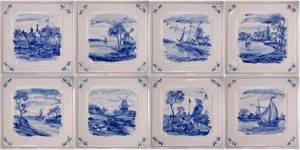
. They are characterized by a blue color scheme on a snow-white background. The dominant motifs are sea and steppe landscapes, ships, mills, shepherdesses, etc.

.
They show the influence of oriental arts. Complex ornaments reflect the way of life of the East. German tiles German tiles
. They are distinguished by clear lines and laconic design. German-made tiles have the greatest consistency in size and practically do not require additional processing before facing.

Russian tiles
. They amaze with the riot of color and variety of ornaments and patterns. Different regions have their own styles of creating patterns and reliefs on tiles.
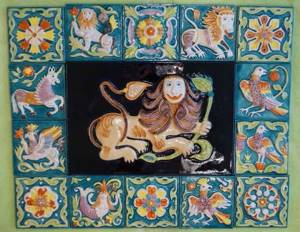
Yaroslavl tiles
. One of the brightest representatives of Russian ceramics. Their difference is in the complex design and muted colors.
To size
It is worth noting that the sizes of tiles from each manufacturer may vary. This is due to production technology. However, tiles comply with the following dimensions:
- tile thickness 45-50 mm;
- dimensions of square tiles (length-width) 200x200, 220x220, rectangular 205x130 mm.
These indicators are regulated by GOST 3742-47.
By type of pump

. The tiller has an inclined cut;
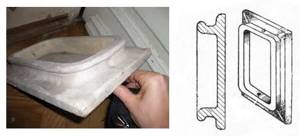
. The presence of a side makes fastening more convenient (due to the presence of mounting holes in them) and reliable.
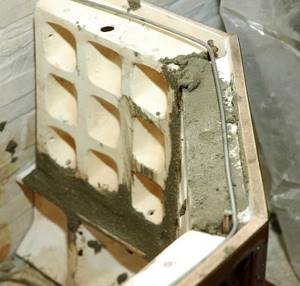
Cellular (cellular) tile tumbler There are tiled tumblers with a more complex side configuration and the presence of several chambers.
The most popular type of product among users today is considered to be a glazed tile with a printed pattern.
Northern tiles. Veliky Ustyug
Veliky Ustyug, located between Moscow and Arkhangelsk, was the largest trading center in which trade routes to the west to Europe, east to Siberia and China and south to Persia crossed. The rich merchants of Veliky Ustyug created their own production of tiles, in the image and likeness of the Stroganov tiles brought by the Stroganov merchants for the construction of the Vvedensky Church. At the crossroads of trade routes, the artistic traditions of Old Rus', Western Europe and the East met, which had a noticeable influence on the work of local artists and craftsmen.
Ustyug churches were primarily decorated with tiles. The temple of Simeon the Stylite, built in 1725 in the Baroque style, attracts attention. Numerous semi-columns and pilasters on the walls of the temple are topped with green tiled capitals of the Corinthian order. The white rectangles of the pilasters enliven the red brick wall, and on a sunny day the tiles create such a festive play of glare that neither marble nor carved stone is capable of.
Ustyug relief tiles were the last representatives of a widely developed family of Russian polychrome architectural ceramics. Having existed until the 19th century, they practically disappeared, leaving smooth painted or ordinary stove tiles as their heirs.
Russian stove in the 21st century
In the current century, the Russian stove is rarely, especially in urban environments, intended for heating and relaxation, and more and more, along with fireplaces, it is used as an important element of room decor. The fireplace, including one built by hand, gravitates more towards the Western image, and the tiled stove - towards the Slavophile. At the same time, an exaggerated importance is attached to the external appearance, and along with real tiles with a rump, simplified samples of them, or even just architectural ceramics, are sometimes made.
Peter's times
On June 27, 1709, the Russian army defeated the Swedish army of Charles XII near Poltava. For our tile history, an interesting episode is the capture of two soldiers - Jan Flegner and Kristan, whom Peter sent “to immediately make smooth white stove tiles in the Swedish manner, and paint grass on them with blue paint.” Peter’s logic is not very clear, because it is strange to assume that absolutely every captured Swede is a specialist in ceramics and is capable of repeating a difficult technology from scratch. Especially considering that the technology was known in the Goncharnaya Sloboda of Moscow and it would have been more effective to invite specialists from there.
However, Peter was distinguished by his temperament and pathological intolerance towards everything Russian, which is apparently why the obvious and simple path was unacceptable to him. We must pay tribute to Jan Flegner - his Swedish hard work and pedantry bore fruit, so the company began producing stove tiles in the Dutch style. And already in 1732, Jan Flegner was invited to his factory by Afanasy Kirillovich Grebenshchikov, the first Russian ceramic industrialist. We wrote about Grebenshchikov in our article “History of Russian Porcelain”.
The Dutch tiles, vigorously implanted by Peter, eventually acquired Russian citizenship and “put on” Russian clothes. Just as the lubok turned from a religious picture into a kind of encyclopedia of folk knowledge and customs, so painted tiles from decorative decoration were reborn into an unusual, long-living “textbook” of geography, history and rules of behavior. The paintings of the new stove tiles reflected the sum of knowledge and ethical rules of that era.
Stylistics of modern tiled fireplaces
The native style of stoves with tiles is Russian ethnic. However, harmonious design, good quality materials, and thoughtful design of the heating device itself allow you to create amazing design installations in a wide variety of stylistic directions.
Particularly popular stylistic concepts:
- Baroque;
- Modern;
- Panel compositions;
- Oriental motifs;
- Art Nouveau;
- Ecological loft;
- European country.
The stylistic presentation is largely influenced by the “homeland” of the finishing material. Tiles from the town of Delphi are traditionally decorated with cobalt painting. The Flemish school is characterized by the use of blue and chocolate ornaments on white or ivory canvas.
590adb6d32d3daecb4301f090dbc309b.jpe b4efdc8885b7a839d098b321e180114e.jpe

06e5e3f27a7ed0a7b539588807036d08.jpe 60a2eb6aeb98f41c83753fff38df753f.jpe eaddea461f69e0b2bc07ae21817a7a82.jpe 0682f11effd7e71af6a22f5829 8ec1da.jpe ef0ecc40afbcc087582efbba2bece98d.jpe d24cf55f98b659ecc195a029aa5fd4de.jpe 2b53047993a00b311137a4dddcf614ff.jpe
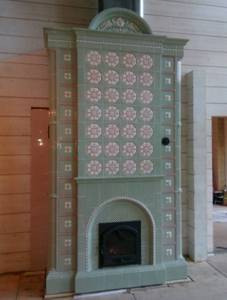
Dutch graphics, which were complemented by interesting French motifs, were distinguished by particularly elegant and sophisticated Provençal watercolors. English fireplaces were decorated only with original British symbols. And today these motives can be freely used and these attributes are created, creating an aristocratic “purely British” interior.
Vladimir and Suzdal
The talent of folk potters and painters was especially evident in the painted tiles of the 18th century. Everything that has been achieved over the centuries in icon painting, in folk engraving - all the best has found its place. Some masters created complex, multifaceted compositions similar to the marks of hagiographic icons. Others used the graphic linearity of popular prints. Depending on the plot, the surrounding ornament was born: houses and fortresses were enclosed in an angular pattern, and human figures or landscapes were enclosed in complex ornate ornaments.
All tiles could be systematized by subject: drawings depicting nature and animals, geographical and ethnographic pictures, everyday scenes, mythological subjects and religious scenes. The masters willingly painted deer, hare, ram, dog, and birds. But images of fish were extremely rare. Interesting are the “ethnographic” images, practically invented by the artists: “Chinese people”, “Arap people”, “Brezalian (Brazilian) woman”, “French comedian”.
The Suzdal Museum contains “sultry” tiles - a curvaceous woman with bare breasts and a raised hem, and at the bottom the signature “although I don’t give beckoning.” Funny scenes are depicted on the tiles of the Intercession Convent: against the backdrop of mountains and houses with Chinese roofs, two naked maidens stand, and two gentlemen sneak towards them. How such stories ended up on the stove of a convent is not entirely clear, but the fact remains.
Painting putty tiles
Paints for drawings on tiles made in this way are selected based on the purpose of the tile. If, for example, it will be installed behind a kitchen stove, it is better to choose a heat-resistant one. In all other cases, you can use acrylic dye. Then the tiles can be washed and cleaned later.
We hope that we have sufficiently covered the topic of the article and answered the question of what a tile is. Now you also know how to make such a finish with your own hands. That's all. We wish you good luck in this interesting business!
Kaluga
The end of the 18th - beginning of the 19th century was accompanied by the flourishing of the Kaluga glass craft. And if smooth white tiles were in fashion in the capitals, then the Kaluga merchants, rich and capricious, did not want to line their stoves with such “poor” tiles. Therefore, the huge Kaluga tile industry specialized in painted tiles, which had several basic visual motifs that distinguished it from all others.
The main subjects of Kaluga tiles were “flowers” - on a white background there is a frame medallion with rock curls and a flower, inside a blue frame with curls there is a yellow lemon painted, “basket” - the same as “limon”, only instead of a lemon a basket with flowers is painted , “tree” - a Christmas tree or an oak tree is drawn in a frame of balls or diamonds on a white oval, “wedding” - the composition is the same, but instead of a tree, an empire-style vase is drawn. After the War of 1812, Kaluga never recovered, and glass production practically ceased to exist, surviving only in the form of a small private artel.
You can read more about Kaluga tiles in our other article.
Tips for choosing material
When purchasing, you should pay special attention to the quality of the material. The tile should not be damaged, fragile, or have any defects
Carefully inspect the end of the product.
If it has a large number of pores, refrain from purchasing. After all, such tiles will absorb a large amount of moisture, and when exposed to temperature, they can become deformed. A high-quality stove tile will serve you for a long time, but with poor material, difficulties will arise already at the installation stage.
The size of the parts is important. Each manufacturer has different sizes, but they must be within the framework of GOST:
- 45-50 – in thickness;
- 200 by 200, 220 by 220, 205 by 130 – by area.
Additional tips:
- It is necessary to compare tiles from the same batch with each other. If they differ by more than 10 mm, then you are unlikely to be able to lay out a beautiful canvas.
- Before purchasing or making material, it is recommended to calculate how many tiles of each type (facade, plinth, corner) are needed for your stove.
- You should add several samples to the amount received for unforeseen expenses: damage, scratches, chips and other damage. Even if you do not use all the material, you can leave it in case some decorative elements are damaged during use.
- You should also decide on the style of the future tiled stove. There is a wide selection of tiles in Dutch, Spanish, Russian, and Yaroslavl styles.

